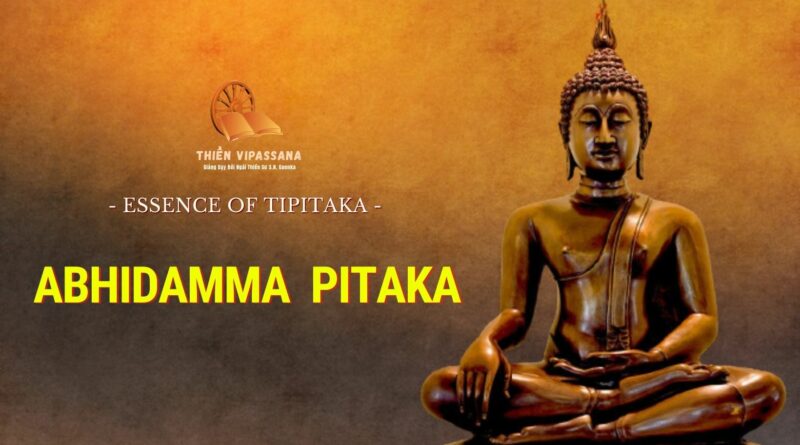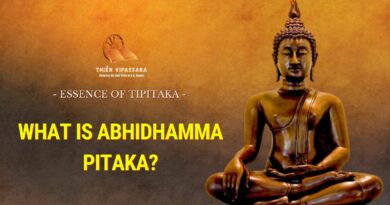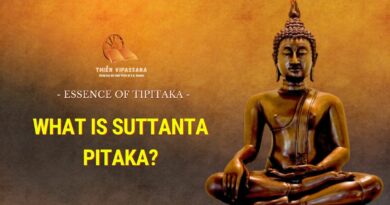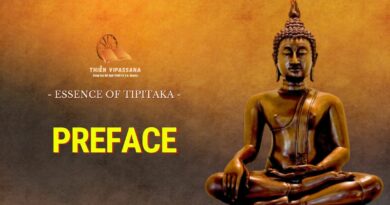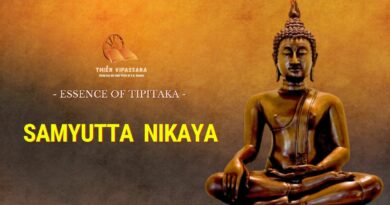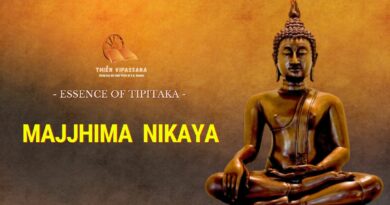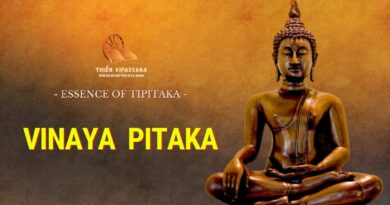10. ABHIDHAMMA PIṬAKA
1 The Dhammasaṅgaṇī Pāḷi
The Dhammasaṅgiṇī, the first book of the Abhidhamma, and the Paṭṭhāna, the last book, are the most important of the seven treatises of Abhidhamma, providing as they do the quintessence of the entire Abhidhamma.
The Dhammasaṅgaṇī enumerates all the dhammas (phenomena) i.e., all categories of nāma, namely, consciousness and mental concomitants; and rūpa, (corporeality). Having enumerated the phenomena, they are arranged into various categories to bring out their exact nature, function and mutual relationship both internally (in our own being) and with the outside world.
The Mātikā
The Dhammasaṅgaṇī begins with a complete list of categories called the Mātikā. The Mātikā serves as a classified table of mental constituents relevant not only to the Dhammasaṅgaṇī but also to the entire system of the Abhidhamma.
The Mātikā consists altogether of one hundred and twenty-two groups, of which the first twenty-two are called the Tikas or Triads (those that are divided under three heads) and the remaining one hundred are called the Dukas or Dyads (those that are divided under two heads).
Examples of Triads are:
(ii) immoral (akusala),
(iii) indeterminate (abyākata);
(b) Vedanā Tika: dhammas that are associated with
(ii) painful feeling,
(iii) neutral feeling.
Examples of Dyads are:
(ii)not roots (na-hetus);
(b) Sahetuka Duka: dhammas that are
(ii) not associated with the hetus.
The Mātikā concludes with a list of the categories of dhamma entitled Suttantika Mātikā made up of forty-two groups of dhamma found in the suttas.
The Four Divisions
Based on these Mātikās of Tikas and Dukas, the Dhammasaṅgaṇī is divided into four divisions:
(ii) Rūpa Kaṇḍa (division concerning corporeality).
(iii) Nikkhepa Kaṇḍa (division that avoids elaboration).
(iv) Aṭṭhakathā Kaṇḍa (supplementary digest).
Of the four divisions, the first two, namely: Cittuppāda Kaṇḍa and Rūpa Kaṇḍa, form the main and the essential portion of the book. They set the model of thorough investigation into the nature, properties, function and interrelations of each of the dhammas listed in the Mātikā, by providing a sample analysis and review of the first Tika namely: the Kusala Tika of kusala, akusala and abyākata dhamma. Cittuppāda Kaṇḍa deals with a complete enumeration of all the states of mind that come under the heading of kusala and akusala. The Rūpa Kaṇḍa is concerned with all the states of matter that come under the heading ofabyākata. Mention is also made of Asaṅkhata Dhātu (nibbāna) without discussing it.
The Nikkhepa Kaṇḍa, the third division, gives, not too elaborately nor too briefly, the summary of distribution of all the Tikas and Dukas, so that their full contents and significance will be become comprehensible and fully covered.
Aṭṭhakathā Kaṇḍa, the last division of the book, is of the same nature of the third division, giving a summary of the dhammas under the different heads of the Tika and Duka groups. However it is in a more condensed form, thus providing a supplementary digest to the first book of the Abhidhamma for easy memorizing.
Order and Classification of the Types of Consciousness as discussed in the Cittuppāda Kaṇḍa.
The Cittuppāda Kaṇḍa gives a statement of the types of consciousness arranged under the three heads of the first Tika, namely:
(ii) Akusala dhamma (i.e. demeritorious consciousness and its concomitants),
(iii) Abyākata dhamma ( i.e. indeterminate consciousness and its concomitants).
The list of mental concomitants for each dhamma is fairly long and repetitive.
The statement of the types of consciousness is followed by identification of the particular type (e.g. kusala dhamma), in the form of question and answer, with regard to the plane and sphere (bhūmi) of consciousness: kāmāvacara (sensuous plane); rūpāvacara (plane of forms); arūpāvacara (plane of no-form); tebhūmaka (pertaining to all the three planes); or lokuttara (supramundane, not pertaining to all the three planes).
The type of consciousness of each plane is further divided into various categories. For example there are eight kinds of kusala dhamma for the sensuous plane (first kusala citta, second kusala citta etc.); twelve kinds of akusala citta; eight kinds of ahetuka kusala vipāka citta and eight kinds of sahetuka vipāka citta under the heading of Abyākata Dhamma.
Then these various categories are further analysed according to:
(ii) Kotthāsa Vāra (the grouping of dhamma). There are twenty-three categories of dhammas which result from synthetical grouping of dhammas into separate categories such askhandhas, āyatanas, dhātus etc.
(iii) Suññata Vāra, which lays stress on the fact that there is no “self”, (atta) or jīva behind all these dhammas; they are only composites, causally formed and conditioned, devoid of any real substance.
The same method of treatment is adopted for the akusala andabyākata types of consciousness.
Rūpa Kaṇḍa
Because Dhammasaṅgaṇī treats all the dhammas (nāmas as well as the rūpas) in the same uniform system of classification, Rūpa Kaṇḍa is only a continuation of the distribution of the dhamma under the categories of the first Tika, which begins in the first division, Cittuppāda Kaṇḍa. In the Cittuppāda Kaṇḍa, the enumeration of the dhammaunder the head “Abyākata” has been only partially done, because theabyākata category of dhamma includes not only the states of mind which are neither meritorious nor demeritorious but also all states of matter and the asaṅkhata dhātu or nibbāna. The portion of dhammaunder the heading of abyākata, which has been left out from the Cittuppāda Kaṇḍa, is attended to in this kaṇḍa.
The method of treatment here is similar, with the difference that instead of mental concomitants, the constituents of matter (i.e. the four primary elements and the material qualities derived from them with their properties and their relationships) are analysed and classified.
2 Vibhaṅga Pāḷi – Book of Analysis
The second book of the Abhidhamma Piṭaka, Vibhaṅga, together with the first book of the Dhammasaṅgaṇī and the third book of the Dhātukathā, forms a closely related foundation for the proper and deep understanding of the Buddha’s Dhamma. Whereas Dhammasaṅgaṇī provides a bird’s eye view of the whole Tika and Duka groups with further systematic arrangements under classified heads, Vibhaṅga and Dhātukathā give a closer view of selected portions of those groups bringing out minute details.
Thus, Kotthāsa Vāra in Dhammasaṅgaṇī explains the way in whichkhandha, āyatana, dhātu, āhāra, indriya, jhānaṅga, and so on, areincluded in the Tika and Duka groups. However it does not furnish complete information about these dhammas. It is Vibhaṅga which provides full knowledge concerning them, stating the exact nature of each dhamma, its constituents and its relationship to other dhammas.
The Vibhaṅga is divided into eighteen chapters each dealing with a particular aspect of the Dhamma, its full analysis and investigation into each constituent. The arrangement and classification into groups and categories follows the same system as in Dhammasaṅgaṇī. Vibhaṅga may therefore be regarded as complementary to the Dhammasaṅgaṇī.
Vibhaṅga explains the following categories of Dhamma:
(ii) Āyatana
(iii) Dhātu
(iv) Sacca
(v) Indriya
(vi) Paṭiccasamuppāda
(vii) Satipaṭṭhāna
(viii) Sammappadhāna
(ix) Iddhipāda
(x) Bojjhaṅga
(xi) Magga
(xii) Jhāna
(xiii) Appammaññā
(xiv) Sikkhāpada
(xv) Paṭisambhidā
(xvi) ñāṇa
(xvii) Khuddhaka vatthu
(xviii) Dhammadhaya.
Each category is analysed and discussed according to two or all three of the following methods of analysis: suttanta bhājanīya-the meaning of the terms and the classification of the dhammas determined according to the Suttanta method; abhidhamma bhājanīya-the meaning of the terms and the classification of the dhammas determined according to the Abhidhamma method; pañha pucchaka-discussions in the form of question and answers.
It may be seen from the above list of the eighteen categories that they may be divided into three separate groups. The first group containing numbers (i) to (vi) deals with mental and corporeal constituents of beings and two laws of nature to which they are constantly subjected (i.e. the Law of Impermanence and the Law of Dependent Origination). The second group containing numbers (vii) to (xii) is concerned with the practice of the holy life which will take beings out of suffering and the rounds of existence. The remaining six categories serve as a supplement to the first two groups, supplying fuller information and details where necessary.
3 Dhātukathā Pāḷi
Although this third book of Abhidhamma Piṭaka is a small treatise, it ranks with the first two books forming an important trilogy, which must be completely digested for the complete understanding of the Abhidhamma. Vibhaṅga, the second book, has one complete chapter devoted to the analysis of dhātus, but the subject matter of dhātu is so important that this treatise is devoted to it for a thorough consideration. The method of analysis here is different from that employed in the Vibhaṅga.
Dhātukathā studies how the Dhamma listed in the Tikas and Dukas of the Mātikās are related to the three categories of khandha, āyatanaand dhātu in their complete distribution i.e., five khandhas, twelve āyatanas and eighteen dhātus. These are discussed in fourteen forms of analytical investigation which constitute the fourteen chapters of Dhātukathā.
4 Puggalapaññatti Pāḷi
Abhidhamma is mainly concerned with the study of abstract truths in absolute terms. But in describing the dhammas in their various aspects, it is not possible to keep to absolute terms only. Inevitably, conventional terms of every day language have to be employed in order to keep the lines of communication open at all. Abhidhamma states that there are two main types of conventional usage; the first type is concerned with terms which describe things that actually exist in reality and the second type describes things which have no existence in reality.
The first three books of the Abhidhamma investigate the absolute truth of the Dhamma in a planned system of detailed analysis employing such terms as khandha, āyatana, dhātu, sacca and indriya. These terms are mere designations which express things that exist in reality and can therefore be classified as conventional usage of the first type referred to above. To the second category of conventional usage belong such expressions such as man, woman, deva, individual etc., which have no existence in reality, but nevertheless are essential for the communication of thoughts.
It becomes necessary therefore to distinguish between these two types of apparent truths. But as the terms khandha, āyatana, dhātu, saccaand indriya have been elaborately dealt with in the first three books, they are dealt with here only briefly. Terms of the second type relating to individuals are given more weight and space in this treatise, hence its title Puggalapaññatti (designation of individuals). Different types of individuals are classified, in ten chapters of the book, according to the manner of enumeration employed in the Aṅguttara Nikāya.
5 Kathāvatthu Pāḷi
Kathāvatthu, like Puggalapaññatti, falls outside the regular system of the Abhidhamma. It does not directly deal with the complex nature of the Dhamma. It is mainly concerned with wrong views such as “person exists; self exists; jīva exists” which were prevalent even in the Buddha’s time; or wrong views such as “arahat falls away from arahatship” which arose after the parinibbāna of the Buddha.
About two hundred and eighteen years after the parinibbāna of the Buddha there were altogether eighteen sects, all claiming to be followers of the Buddha’s teaching. Of these only the Theravādins were truly orthodox, while the rest were all schismatic. The emperor Asoka set about removing the impure elements from the order with the guidance and assistance of the elder Moggaliputtatissa who was an accomplished arahat. Under his direction, the order held in concord the uposatha ceremony which had not been held for seven years because of dissensions and the presence of false bhikkhus in the order.
At that assembly, the Venerable Moggaliputtatissa expounded on points of views, made up of five hundred orthodox statements and five hundred statements of other views, in order to refute the wrong views that had crept into the Sangha and that might in the future arise. He followed the heads of discourses, Mātikā, outlined by the Buddha himself and analysed them in detail into one thousand statements of views. This collection of statements of views was recited by one thousand selected theras who formed the Third Great Synod, to be incorporated into the Abhidhamma Piṭaka.
The style of compilation of this treatise is quite different from that of other treatises, written as it is in the form of dialogue between two imaginary debaters, one holding the heterodox views of different sects and the other representing the orthodox views.
6 Yamaka Pāḷi
The Dhammasaṅgaṇī, the Vibhaṅga and the Dhātukathā examine the world of reality, named saṅkhāraloka. Puggalapaññatti and Kathāvatthu deal with beings and individuals which also exist in their own world of apparent reality, know as sattaloka. Where the dhammaof saṅkhāraloka and beings of the sattaloka co-exist is termedokāsaloka. Yamaka sets out to define and analyse the interrelationship of dhammas and puggalas as they exist in these three worlds.
This is accomplished in the form of pairs of questions, which gives it the title of Yamaka. The logical processes of conversion (anuloma) and complete inversion (paṭiloma) are applied to determine the full implications and limitations of a term in its relationship with the others. Any equivocal elements of a term (saṃsaya) are avoided by showing, through such arrangement of questions, how other meanings of the term do not fit in a particular context.
The following pairs of questions may be taken as an
example:
To the question, “May all rūpa be called rūpakkhandha?” the answer is “Rūpa is also used in such expressions as piya rūpa (loveable nature),eva rūpa (of such nature), but there it does not mean rūpakkhandha.“
But to the question “May all rūpakkhanda be called rūpa?” the answer is “Yes”, because rūpakkhandha is a very wide term and includes such terms as piya rūpa, eva rūpa, etc.
7 Paṭṭhāna Pāḷi
Paṭṭhāna Pāḷi, the seventh and last book of the Abhidhamma, is called the Mahā Pakāraṇa, the “Great Book” announcing the supreme position it occupies and the height of excellence it has reached in its investigations into the ultimate nature of all the dhammas in the universe.
The Dhammasaṅgaṇī gives an enumeration of these dhammasclassifying them under the Tika and Duka groups. Vibhaṅga analyses them to show what dhammas are contained in the major categories ofkhandhas, āyatanas, dhātus etc. Dhātukathā studies the relationship of dhammas listed in the Mātikā with each component of these major categories of khandhas, āyatanas and dhātus. Yamaka resolves ambiguity in the internal and external relationship of each dhamma.Paṭṭhāna forming the last book of the Abhidhamma brings together all such relationships in a co-ordinated form to show that the dhammas do not exist as isolated entities but they constitute a well ordered system in which the smallest unit conditions the rest of it and is also being conditioned in return. The arrangement of the system is so very intricate, complex, highly thorough and complete that it has earned for this treatise the reputation of being deep, profound and unfathomable.
An Outline of the Paṭṭhāna System of Relations
Paṭṭhāna, made up of the words “pa” and “ṭhāna”, means a system of relations. The great treatise of Paṭṭhāna arranges all conditioned things (twenty-two Tikas and one hundred Dukas of the Mātikā) under twenty-four kinds of relations, and describes and classifies them into a complete system for understanding the mechanics of the universe of Dhamma. The whole work is divided into four great divisions, namely:
(ii) Paccanīya Paṭṭhāna which studies the instances in which paccaya relations do not exist between the dhammas;
(iii) Anuloma Paccanīya Paṭṭhāna which studies the instances in which some of the paccaya relations exist between the dhammaswhile the others do not;
(iv) Paccanīya Anuloma Paṭṭhāna which studies the instances in which some of the paccaya relations do not exist between the dhammas, while the others do exist.
The twenty-four paccaya relations are applied to these four great divisions in the followings six ways:
-the twenty-four paccayas are applied to the dhammas in their twenty-four Tika groups.
(ii) Duka Paṭṭhāna
-the twenty-four paccayas are applied to the dhammas in their one hundred Duka groups.
(iii) Duka-Tika Paṭṭhāna
-the twenty-four paccayas applied to the dhammas in their twenty-four Tikas mixed with one hundred Duka groups.
(iv) Tika-Duka Paṭṭhāna
-the twenty-four paccayas applied to the dhammas in their twenty-four Tikas mixed with one hundred groups.
(v) Tika-Tika Paṭṭhāna
-the twenty-four paccayas applied to the dhammas in the twenty-four Tika groups mixed with one another.
(vi) Duka-Duka Paṭṭhāna
-the twenty-four paccayas applied to the dhammas in their one hundred Duka groups mixed with one another.
The four Paṭṭhānas of the four great divisions when combined with the six Paṭṭhānas of the six ways result in twenty-four treatises which constitute the gigantic compilation of abstract Abhidhamma known as the Mahāpakāraṇa or, as the commentary and sub-commentary name it, “Anantanaya Samanta Paṭṭhāna” to denote its great profundity and depth.

